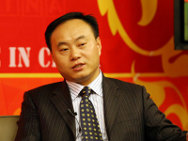
Don’t let the sun go down on Shi China has given off-grid power a key role in its massive strategic move to renewable energy. Plans include large-scale on-grid solar projects, urban building photo voltaic projects, nuclear power and wind-solar hybrid installations as well as large and small-scale off-grid solar schemes in rural areas.
Late last month the People’s Republic of China President Hu promised the United Nations General Assembly that his country would “vigorously develop renewable energy”, and increase the share of non-fossil fuels in energy use to around 15 percent by 2020.
Agreement with First Solar
Last week Chinese government officials signed an agreement with US solar developer First Solar for a 2,000-megawatt photovoltaic farm to be built in the Mongolian desert. First Solar says that when completed, the solar farm will generate enough electricity to power about three million Chinese homes.
Two days later Suntech, one of the country’s largest renewable energy firms, opened a 10MW solar power plant, making it China’s largest solar photo voltaic plant to be connected to the grid. The move is the first phase of a 50MW solar plant that is expected to be completed by 2011. It is estimated that the project, will save approximately 20,000 tons of carbon dioxide emissions per year.
First renewable billionaire
Suntech is owned by Australian-educated scientist Shi Zhengrong (pictured), said to be the world’s first solar billionaire. Suntech’s rapid growth has been aided by generous support from the Chinese government. Last year claims Shi, Suntech overtook Sharp as the world’s biggest producer of solar panels. Within three, he predicts it will also be the global leader in solar cells and solar modules. By 2010, the company’s factories will churn out enough photovolataic cells per year to generate 2 gigawatts of electricity, equivalent to four new power plants.
The move to renewables is significant not only for China but the whole world. China is the world’s largest energy producer and second largest energy consumer. It is an implicit acceptance by the Asian giant that economic growth cannot be sustained by fossil fuels.
China weaning off fossil fuel
Despite its autocratic and archaic image, China has been slowly weaning itself off fossil fuels for decades. China’s coal consumption has been reduced from 96 percent of its total energy use in 1952 to 68 percent last year. The use of hydro nuclear and wind power was raised from 1.61 percent to 9.5 percent.
However China is still the world’s largest extractor of coal and the fifth largest producer of crude oil. So its approach to the issue of fossil fuel and renewables is largely driven by pragmatic cost and efficiency arguments rather than moral or ethical green considerations.
First plug-in hybrid
For instance, China’s pioneering automaker BYD began selling the world’s first plug-in hybrid vehicle in December last year largely in a bid to save fuel. It plans to sell the vehicle to the European and North American markets.
Official figures show China cut its energy consumption per unit of GDP by 10.1 percent between 2006 and 2008, reducing carbon dioxide emissions by 750 million tonnes. The country reported a drop of 3.35 percent of energy consumption per unit of GDP in the first half of this year alone compared to the same period a year ago.
Although the reduction is at least in part due to falling demand for industrial products, it does mean that China is on course for a 20 percent cut on its 2005 emissions by 2010.
3 Responses
I suggest you read the following article for the information you require
https://www.pvgroup.org/NewsArchive/ctr_041595
@ V.M.Soar What kind of rare elements, and which PV cells require them? what % of produced solar panels are using these PV cells with rare elements?
No mention of the fact that photovoltaic cells require rare elements for their manufacture and are therefore unsustainable in the long term